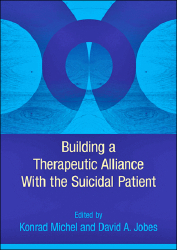
The Aeschi Working Group
MEETING THE SUICIDAL PERSON
The therapeutic approach to the suicidal patient
THE BOOK
| FUTURE EVENTS |
| NEW: www.assip.ch |
| THE BOOK: BUILDING A THERAPEUTIC ALLIANCE WITH THE SUICIDAL PATIENT |
| THE GUIDELINES FOR CLINICIANS |
| PAST EVENTS |
| 1st Aeschi Conference |
| 2nd Aeschi Conference |
| 3rd Aeschi Conference |
| 4th Aeschi Conference |
| 5th Aeschi Conference |
| 6th Aeschi Conference |
| 7th Aeschi Conference (Aeschi West) |
| 8th Aeschi Conference (Aeschi 8) |
| 9th Aeschi Conference (Aeschi 9) |
| 10th Aeschi Conference (Aeschi 10) |
| PROBLEMS
IN CLINICAL PRACTICE |
| The usual clinical practice |
| Clinicians' attitudes |
| Patients' dissatisfaction |
| Non-attendance in aftercare |
| Treatment failures |
| A PATIENT-ORIENTED APPROACH |
| New perspectives |
| Patients' narratives |
| Patients' inner experiences |
| Joining the patient |
| CAMS |
| The
Narrative Action Theoretical (NAT) approach |
| Mental Pain |
| INFORMATIONS |
| The Aeschi Group |
| Publications |
| Links |
| Hotel Aeschi Park |
| Destination Aeschi |
| Download main text as pdf here |
| Download Guidelines for Clinicians as pdf here |
| Home |
THE BOOK American Psychological Association |
|
| Pages: 414 ISBN: 978-1-4338-0907-1 Publication Date: November 2010 Format: Hardcover |
Synopsis
The quality of the therapeutic alliance is a well established factor for successful therapy process and outcome. When it comes to therapy for suicidal patients, the therapeutic alliance can quite literally save a person's life.
In this book, editors Konrad Michel and David A. Jobes have enlisted an elite group of clinicians and researchers to explore what has become known as the “Aeschi approach” to clinical suicide prevention. According to this view, mental health professionals working with patients at risk for suicide must recognize a fundamental conflict at the heart of good clinical practice: while they are experts in the assessment and treatment of disorders of mental health, when it comes to the patient’s suicidal story, the patient is the expert. Successful interventions with suicidal patients must therefore be empathic and honor the very personal perspective of the patient.
This exceptional volume addresses a wide range of issues, from the principles and methods of establishing a working alliance, to patient-oriented therapies for suicidality. Moreover, the text discusses practical clinical matters related to specific treatments across theoretical orientations and modalities. Above all, this book provides essential guidance for any clinician seeking a sensible and compelling approach to working effectively with suicidal patients.
Chapters by
J.T. Maltsberger, D.A. Jobes, E. Ballard, K. Michel, L. Valach, J.G. Allen, M. Schechter, M. Goldblatt, I. Orbach, R. Young, J. Holmes, M.D. Rudd, G.K. Brown, A.A. Leenaars, S. Rizvi, M.M. Linehan, A. Wenzel, I. Weinberg, E. Ronningstam, T. Lineberry, M. Bostwick
For more details see
Publication Flyer (pdf)
APA BOOKS
Amazon.com
„This book is an excellent and long overdue contribution that will advance the field of suicidology! Michel and Jobes and their contributors share their perspectives on the Aeschi point of view, helping us connect the dots between the medical, risk factor, and crisis intervention models of suicide intervention and the critical need for a strong alliance with the suicidal patient as a co-collaborator in the therapeutic process. Building a Therapeutic Alliance With the Suicidal Patient is a must-read for mental health clinicians and studentsregardless of their discipline!“
James R. Rogers, PhD, Professor, Co-Training Director of the Collaborative Program in Counseling Psychology at The University of Akron, President of the American Association of Suicidology, and Fellow of the International Academy of Suicide Research
„Therapeutic innovations with suicidal people often "sound good on paper" but fall short in practice because they presume a sound working relationship with an individual who, almost by definition, struggles in relating to others. This book, written by clinicians for clinicians, fills that void by helping the reader to understand the complex process of joining with the suicidal individual in the collaborative pursuit of healing. This book deserves a place among the key books in the library of every clinician working with patients at risk for suicide:“
Thomas E. Ellis, PsyD, ABPP, Professor, Menninger Department of Psychiatry and Behavioral Sciences, Baylor College of Medicine, Director of Psychology, The Menninger Clinic
„The expert insights and research found in this important book should be required reading for those who treat suicidal patients. Far too many clinicians-if they can talk about suicide comfortably at all-see their patients as clusters of symptoms, diagnostic puzzles, and soon-to-be recipients of one medication or another. Suicidal patients are not like other patients; only the promotion of hope through a strong therapeutic alliance has any chance of success-for the patient or the therapist.“
Paul Quinnett, PhD, President and CEO, QPR Institute
